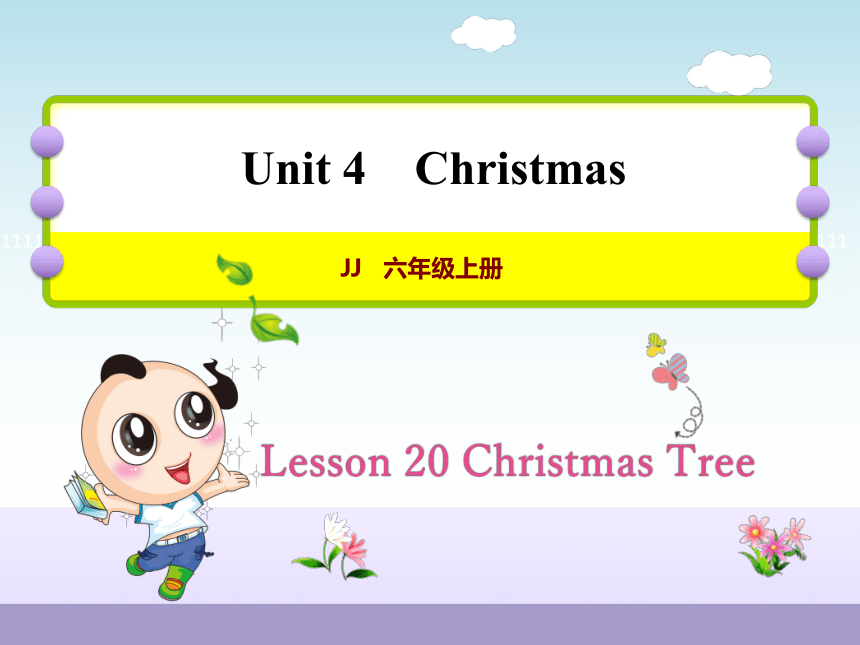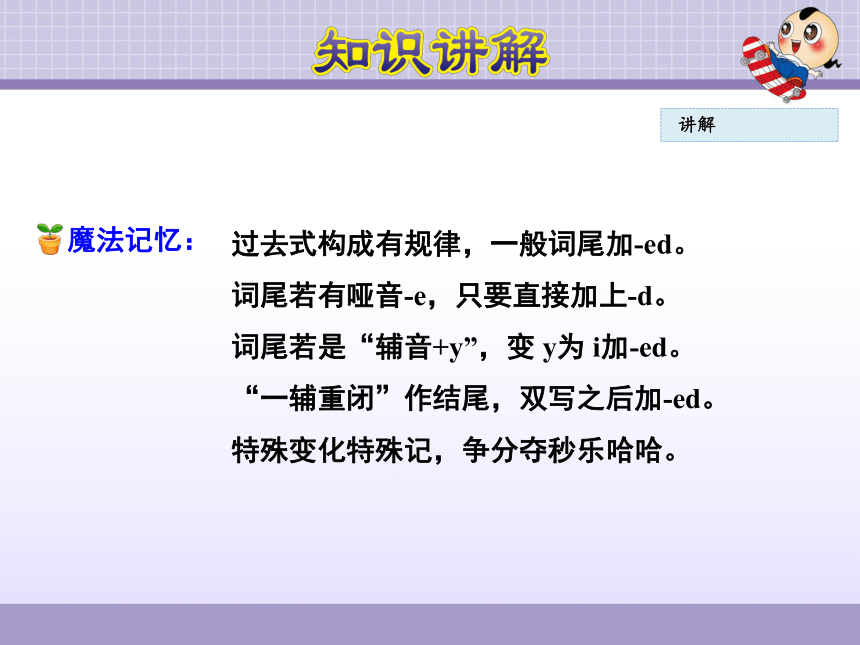Lesson 20 Christmas Tree 课件+素材
文档属性
| 名称 | Lesson 20 Christmas Tree 课件+素材 |  | |
| 格式 | zip | ||
| 文件大小 | 3.0MB | ||
| 资源类型 | 教案 | ||
| 版本资源 | 冀教版(三年级起点) | ||
| 科目 | 英语 | ||
| 更新时间 | 2017-11-23 12:25:24 | ||
图片预览









文档简介
课件24张PPT。111111111111111111111111111111111111111111111111111111111111111111111111111111111111111111111111111111111111111111111111111111111111111111111Unit 4 ChristmasJJ 六年级上册 Lesson 20 Christmas Tree 1. Iet’s put up a Christmas tree! Jenny: Yesterday my dad bought a Christmas tree!
Let’s put it up. It’s fun.
Li Ming: First, I’m going to put the lights on the tree.
Jenny: Then I’m going to put Christmas things on the tree.
Danny: The star always goes on top!
Jenny: Now, we put our gifts under the tree.
Danny: There! It’s done!
Li Ming: It’s beautiful.知识点 1讲解 Yesterday my dad bought a Christmas tree!
昨天我的爸爸买了一棵圣诞树!
一般过去时表示过去某个时间里发生的动作或存在的状态,常与表示过去的时间状语连用,如:
yesterday,last week,in 1993等。 此句时态为一般过去时,bought是buy的过去式。一般过去时的意义及用法如下:意义:讲解
(1) 含有be 动词的一般过去时:
①肯定句:主语+was(were)+ 其他.
例句:I was late yesterday. 昨天我迟到了。
②否定句:主语+was(were)+ not + 其他.
例句:We were not busy yesterday. 我们昨天不忙。
③ 一般疑问句:Was(Were)+ 主语+ 其他?
例句:Were you ill yesterday? 你昨天生病了吗?
肯定回答:Yes, I was. 是的,我生病了。
否定回答:No, I wasn’t. 不,我没生病。用法:讲解(2)含有实义动词的一般过去时:
①肯定句:主语+ 动词过去式+ 其他.
例句:I went home at nine o’clock yesterday.
我昨天九点钟回家的。
②否定句:主语+ didn’t + 动词原形+ 其他.
例句:I didn’t go home yesterday. 我昨天没回家。
③ 一般疑问句:Did+ 主语+ 动词原形+ 其他?
例句:Did you go home yesterday? 你昨天回家了吗?
肯定回答: Yes, I did. 是的,我回家了。
否定回答:No, I didn’t. 不,我没回家。讲解(3)动词变过去式的规则变化:过去式构成有规律,一般词尾加-ed。
词尾若有哑音-e,只要直接加上-d。
词尾若是“辅音+y”,变 y为 i加-ed。
“一辅重闭”作结尾,双写之后加-ed。
特殊变化特殊记,争分夺秒乐哈哈。讲解(4 )动词变过去式的不规则变化:讲解知识点 2讲解put up 装饰;张贴 Let’s put up the Christmas tree.
让我们装饰圣诞树吧。 put up 是动词put和副词up构成的“动副型”短语,如果要接名词,名词可以放在 put 和 up 的中间,也可以放在up的后面;如果要接代词,代词必须放在put和up的中间。例句:讲解 put up 还有“举起”的意思。 例句:拓展This is a Christmas tree. Let’s put it up.
这是一棵圣诞树。让我们装饰它吧。知识点 3讲解then /een/ adv. 然后;接着
t + hen(母鸡)= then than(prep.)比 they(pron.)他 /她/它们First we make a big snowball. Then we make a small snowball. 首先我们制作一个大的雪球。
然后我们制作一个小的雪球。例句:形近词:加法记忆法:2. Let’s do it! Draw and write. Yesterday I bought a Christmas tree.
Tomorrow I’m going to put it up. ____________________________
____________________________
____________________________Yesterday I bought a Christmas lights.Tomorrow my father and I are going to put them on our Christmas tree. tomorrow /t?'m?r??/ n. & adv. 明天;
明日;在明天,在明日知识点 4讲解Tomorrow I’m going to buy a dress.
明天我打算买一件连衣裙。 tomorrow常与一般将来时连用。例句: 短语: 用法:tomorrow night 明天晚上
tomorrow morning 明天早上讲解today,today 是今天,tomorrow,tomorrow 是明天。
yesterday,yesterday 是昨天,我们 happy 每一天。3. Walk, walked and be going to walkLet’s find the differences!
Yesterday
Danny walked to school.
Mrs. Smith bought a scarf.
I brought a Christmas tree to my family.
Often
Danny walks to the bus stop.
Mrs. Smith buys some gifts.
I bring some lights for the Christmas tree.
Tomorrow
Danny is going to walk to the park.
Mrs. Smith is going to buy some food.
I am going to bring a star for the tree.一般现在时、一般将来时的用法知识点 5讲解一般现在时
一般现在时表示经常发生的动作或存在的状态,通常与表示频率的副词(如:often,sometimes,usually,always等)连用。如果句子中的动词是be动词,可以用am,is,are。如果句子中的动词是行为动词,主语是非第三人称单数,那么行为动词要用原形。 讲解
如果句子中的动词是行为动词,且主语是第三人称单数时,那么句子中的行为动词也要用第三人称单数形式。Jenny likes to sing songs.詹妮喜欢唱歌。
讲解Mr. Li ________(like)to go for a walk
with his family.likes
点拨:
这句话的主语Mr. Li是第三人称单数,句中的谓语动词like也要用第三人称单数形式,即likes。句意为:李先生喜欢和他的家人一起去散步。 讲解一般将来时表示将要发生的动作或将来存在的状态,通常与表示将来的时间状语(如:tomorrow)连用,其结构是“主语+ am / is / are going to +动词原形+其他. ”。其中be going to是现在进行时表将来,表示“将要……”。
一般将来时I’m going to make breakfast tomorrow.
明天我将要做早饭。例句:一、用所给单词的适当形式填空。
(1)— ______(are)they at school yesterday?
—Yes, they______ (are). /
No, they ________(are).
(2)_______(do)you _______ (go) to work last weekend?
(3)— _______(do) he ______(buy) a gift for his mother?
—Yes, he did. / No, he________(do). Werewereweren’t Did go Did buy didn’t二、按要求完成下列句子。
(1)She ate good food last Sunday.(变为一般疑问句)
________ she ________ good food last Sunday?
(2)did,do,yesterday,you,what (?)(连词成句)
___________________________________
DideatWhat did you do yesterday? 本节课我们学习了以下知识,请同学们一定加强巩固,以便能和同学们进行灵活交流哦!重点词汇:tomorrow, then?
重点短语:put up ?
重点句式:Yesterday my dad bought a Christmas tree! Thank you!
Let’s put it up. It’s fun.
Li Ming: First, I’m going to put the lights on the tree.
Jenny: Then I’m going to put Christmas things on the tree.
Danny: The star always goes on top!
Jenny: Now, we put our gifts under the tree.
Danny: There! It’s done!
Li Ming: It’s beautiful.知识点 1讲解 Yesterday my dad bought a Christmas tree!
昨天我的爸爸买了一棵圣诞树!
一般过去时表示过去某个时间里发生的动作或存在的状态,常与表示过去的时间状语连用,如:
yesterday,last week,in 1993等。 此句时态为一般过去时,bought是buy的过去式。一般过去时的意义及用法如下:意义:讲解
(1) 含有be 动词的一般过去时:
①肯定句:主语+was(were)+ 其他.
例句:I was late yesterday. 昨天我迟到了。
②否定句:主语+was(were)+ not + 其他.
例句:We were not busy yesterday. 我们昨天不忙。
③ 一般疑问句:Was(Were)+ 主语+ 其他?
例句:Were you ill yesterday? 你昨天生病了吗?
肯定回答:Yes, I was. 是的,我生病了。
否定回答:No, I wasn’t. 不,我没生病。用法:讲解(2)含有实义动词的一般过去时:
①肯定句:主语+ 动词过去式+ 其他.
例句:I went home at nine o’clock yesterday.
我昨天九点钟回家的。
②否定句:主语+ didn’t + 动词原形+ 其他.
例句:I didn’t go home yesterday. 我昨天没回家。
③ 一般疑问句:Did+ 主语+ 动词原形+ 其他?
例句:Did you go home yesterday? 你昨天回家了吗?
肯定回答: Yes, I did. 是的,我回家了。
否定回答:No, I didn’t. 不,我没回家。讲解(3)动词变过去式的规则变化:过去式构成有规律,一般词尾加-ed。
词尾若有哑音-e,只要直接加上-d。
词尾若是“辅音+y”,变 y为 i加-ed。
“一辅重闭”作结尾,双写之后加-ed。
特殊变化特殊记,争分夺秒乐哈哈。讲解(4 )动词变过去式的不规则变化:讲解知识点 2讲解put up 装饰;张贴 Let’s put up the Christmas tree.
让我们装饰圣诞树吧。 put up 是动词put和副词up构成的“动副型”短语,如果要接名词,名词可以放在 put 和 up 的中间,也可以放在up的后面;如果要接代词,代词必须放在put和up的中间。例句:讲解 put up 还有“举起”的意思。 例句:拓展This is a Christmas tree. Let’s put it up.
这是一棵圣诞树。让我们装饰它吧。知识点 3讲解then /een/ adv. 然后;接着
t + hen(母鸡)= then than(prep.)比 they(pron.)他 /她/它们First we make a big snowball. Then we make a small snowball. 首先我们制作一个大的雪球。
然后我们制作一个小的雪球。例句:形近词:加法记忆法:2. Let’s do it! Draw and write. Yesterday I bought a Christmas tree.
Tomorrow I’m going to put it up. ____________________________
____________________________
____________________________Yesterday I bought a Christmas lights.Tomorrow my father and I are going to put them on our Christmas tree. tomorrow /t?'m?r??/ n. & adv. 明天;
明日;在明天,在明日知识点 4讲解Tomorrow I’m going to buy a dress.
明天我打算买一件连衣裙。 tomorrow常与一般将来时连用。例句: 短语: 用法:tomorrow night 明天晚上
tomorrow morning 明天早上讲解today,today 是今天,tomorrow,tomorrow 是明天。
yesterday,yesterday 是昨天,我们 happy 每一天。3. Walk, walked and be going to walkLet’s find the differences!
Yesterday
Danny walked to school.
Mrs. Smith bought a scarf.
I brought a Christmas tree to my family.
Often
Danny walks to the bus stop.
Mrs. Smith buys some gifts.
I bring some lights for the Christmas tree.
Tomorrow
Danny is going to walk to the park.
Mrs. Smith is going to buy some food.
I am going to bring a star for the tree.一般现在时、一般将来时的用法知识点 5讲解一般现在时
一般现在时表示经常发生的动作或存在的状态,通常与表示频率的副词(如:often,sometimes,usually,always等)连用。如果句子中的动词是be动词,可以用am,is,are。如果句子中的动词是行为动词,主语是非第三人称单数,那么行为动词要用原形。 讲解
如果句子中的动词是行为动词,且主语是第三人称单数时,那么句子中的行为动词也要用第三人称单数形式。Jenny likes to sing songs.詹妮喜欢唱歌。
讲解Mr. Li ________(like)to go for a walk
with his family.likes
点拨:
这句话的主语Mr. Li是第三人称单数,句中的谓语动词like也要用第三人称单数形式,即likes。句意为:李先生喜欢和他的家人一起去散步。 讲解一般将来时表示将要发生的动作或将来存在的状态,通常与表示将来的时间状语(如:tomorrow)连用,其结构是“主语+ am / is / are going to +动词原形+其他. ”。其中be going to是现在进行时表将来,表示“将要……”。
一般将来时I’m going to make breakfast tomorrow.
明天我将要做早饭。例句:一、用所给单词的适当形式填空。
(1)— ______(are)they at school yesterday?
—Yes, they______ (are). /
No, they ________(are).
(2)_______(do)you _______ (go) to work last weekend?
(3)— _______(do) he ______(buy) a gift for his mother?
—Yes, he did. / No, he________(do). Werewereweren’t Did go Did buy didn’t二、按要求完成下列句子。
(1)She ate good food last Sunday.(变为一般疑问句)
________ she ________ good food last Sunday?
(2)did,do,yesterday,you,what (?)(连词成句)
___________________________________
DideatWhat did you do yesterday? 本节课我们学习了以下知识,请同学们一定加强巩固,以便能和同学们进行灵活交流哦!重点词汇:tomorrow, then?
重点短语:put up ?
重点句式:Yesterday my dad bought a Christmas tree! Thank you!
同课章节目录
- Unit 1 Li Ming Goes to Canada
- Lesson 1 At the Airport
- Lesson 2 Jenny's House
- Lesson 3 Making Breakfast
- Lesson 4 Making Dinne
- Lesson 5 In the Living Room
- Lesson 6 Baby Becky at Home
- Unit 2 School in Canada
- Lesson 7 On the School Bus
- Lesson 8 Li Ming Meets Jenny's class
- Lesson 9 Mr. Wood Teaches a Lesson
- Lesson 10 How Many Are There ?
- Lesson 11 Always do your homework!
- Lesson 12 Be Safe on the Way
- Unit 3 Winter in canada
- Lesson 13 Seasons
- Lesson 14 Snow! It's Winter!
- Lesson 15 Winter Fun
- Lesson 16 A Skating Lesson
- Lesson 17 I Like All Seasons!
- Lesson 18 The Snowman
- Unit 4 Christmas
- Lesson 19 Christmas Is Coming!
- Lesson 20 Oh,Christmas Tree
- Lesson 21 Christmas Cards
- Lesson 22 Christmas Gifts
- Lesson 23 It's Christmas Morning!
- Lesson 24 Maddy's Christmas
